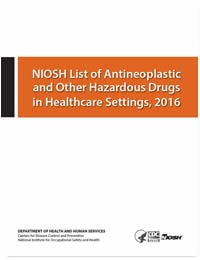NIOSH List of Antineoplastic and Other Hazardous Drugs in Healthcare Settings, 2016
Sept 2016
DHHS (NIOSH) Publication Number 2016-161 (Supersedes 2014-138)

The National Institute for Occupational Safety and Health (NIOSH) Alert: Preventing Occupational Exposures to Antineoplastic and Other Hazardous Drugs in Health Care Settings was published in September 2004. In Appendix A of the Alert, NIOSH identified a sample list of major hazardous drugs. The list was compiled from information provided by four institutions that had generated lists of hazardous drugs for their respective institutions, as well as a list from the Pharmaceutical Research and Manufacturers of America (PhRMA). The 2004 list was updated in 2010, 2012 and 2014. A new format was developed for the 2014 list of hazardous drugs, as described below. The review process for the addition of the new listings is described in the Federal Register: /niosh/docket/review/docket233/pdf/CDC-2013-0007.pdf.
The current update (2016) adds 34 drugs and includes a review of the 2004 list. The National Institute for Occupational Safety and Health (NIOSH) of the Centers for Disease Control and Prevention (CDC) has updated its list of hazardous drugs for 2016. This list includes drugs reviewed by NIOSH from January 2012 to December 2013. Additional information for the 2016 update can be found at: Federal Register Notice
May 9, 2023
The manufacturers of trabectedin (Yondelis®), inotuzumab ozogamicin (Besponsa™), polatuzumab vedotin (Polivy™), enfortumab vedotin (Padcev™), trastuzumab deruxtecan (Enhertu®), sacituzumab govitecan (Trodelvy™), loncastuximab tesirine (Zynlonta™), melphalan flufenamide (Pepaxto®), belantamab mafodotin (Blenrep), and tisotumab vedotin-tftv (Tivdak™) recommend that they be handled as hazardous drugs. Therefore, NIOSH considers these drugs to be included in Table 1 of the NIOSH list of hazardous drugs. For additional information, see the package inserts for these drugs.
| Drug | AHFS Classification | Links | Date Approved |
|---|---|---|---|
| trabectedin (Yondelis®) | 10:00 Antineoplastic Agents | DailyMed | October 23, 2015 |
| inotuzumab ozogamicin (Besponsa™) | 10:00 Antineoplastic Agents | DailyMed | August 17, 2017 |
| polatuzumab vedotin (Polivy™) | 10:00 Antineoplastic Agents | DailyMed | June 10, 2019 |
| enfortumab vedotin (Padcev™) | 10:00 Antineoplastic Agents | DailyMed | December 18,2019 |
| trastuzumab deruxtecan (Enhertu®) | 10:00 Antineoplastic Agents | DailyMed | December 20, 2019 |
| sacituzumab govitecan (Trodelvy™) | 10:00 Antineoplastic Agents | DailyMed | May 12, 2020 |
| Loncastuximab tesirine (Zynlonta™) | 10:00 Antineoplastic Agents | DailyMed | May 28, 2021 |
| melphalan flufenamide (Pepaxto®) | 10:00 Antineoplastic Agents | DailyMed | May 28, 2021 |
| belantamab mafodotin (Blenrep) | 10:00 Antineoplastic Agents | DailyMed | May 28, 2021 |
| tisotumab vedotin-tftv (Tivdak™) | 10:00 Antineoplastic Agents | DailyMed | March 23, 2022 |
| lurbinectedin (Zepzelca®) | 10:00 Antineoplastic Agents | DailyMed | May 9, 2023 |
| mirvetuximab soravtansine (ElahereTM) | 10:00 Antineoplastic Agents | DailyMed | May 9, 2023 |
January 10th, 2019
NIOSH has determined it is unlikely that risperidone (Risperidal®) poses a carcinogenic, reproductive, or developmental hazard to workers in a healthcare setting and is no longer considered a hazardous drug by NIOSH.
January 10th, 2019
NIOSH has determined it is unlikely that paliperidone (Invega®) poses a carcinogenic, reproductive or developmental hazard to workers in a healthcare setting and is no longer considered a hazardous drug by NIOSH.
April 12, 2017
NIOSH has determined that telavancin (VIBATIV®) does not meet the NIOSH definition of a hazardous drug and is no longer considered a hazardous drug by NIOSH.
Click here for the NIOSH List of Antineoplastic and Other Hazardous Drugs in Healthcare Settings, 2016.
NIOSH has released the Procedures for Developing the NIOSH List of Hazardous Drugs in Healthcare Settings:
